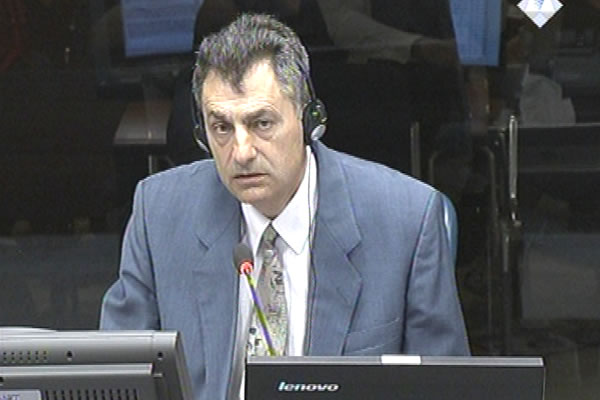Home
THIN LINE BETWEEN UNLAWFUL AND LAWFUL SHELLING
In his evidence at Ratko Mladic’s trial, Colonel Savo Simic explained that the shelling of civilian facilities, densely populated areas or civilian routes was ‘unlawful’, but only if those facilities were not located near any enemy firing positions
 Savo Simic, defence witness at Rako Mladic trial
Savo Simic, defence witness at Rako Mladic trial The last of Ratko Mladic’s defense witnesses for this week is Colonel Savo Simic. From May 1992 to May 1994, Simic was the artillery chief in the 1st Sarajevo Motorized Brigade. Simic’s statement to Radovan Karadzic’s defense and the transcript of his evidence at Karadzic’s in November 2012 were admitted into evidence.
In the statement, Simic notes, ‘I and members of my unit never demonstrated in combat the intention to inflict civilian casualties or to terrorize civilians’. According to the witness, the VRS artillery engaged targets ‘almost exclusively in defense’. Speaking about the Markale incidents in February 1994 and in August 1995, Simic says he cannot believe that the projectiles were fired from the positions under the Bosnian Serb control. The first attack on the town market killed 66 persons and wounded 140. In the second shelling, 43 people died and 75 were injured.
In Simic’s view, the mortar shells that hit Dobrinja in July 1993 and Alipasino Polje in January 1994 were not fired from the Serb firing positions in Nedzarici; he thus contradicts the findings of an official investigation. According to Simic, the shells flew in from the positions controlled by the Muslim forces in the Butmir area. Thirteen civilians were killed in the attack on the water queue in Dobrinja; six children were killed in Alipasino Polje and five other persons were injured. Today Simic explained that the shell could have come from both the Serb and Muslim positions. The investigators should have established not just the trajectory, but also the range of the shell, Simic said.
In the examination-in-chief Simic listed the artillery pieces he had in his unit. He also identified some of the positions where mortars and multiple rocket launchers were located, including Han Pijesak and Milici. Some weapons in Simic’s arsenal could fire 32 rockets in six seconds, but Simic complained that his forces often could not fire a ‘full salvo’ because he had to conserve ammunition and there were not enough targets that would require such intense fire.
Simic confirmed that it was ‘unlawful to shell densely populated areas or routes used by civilians’ prompting the prosecutor to show him an UNPROFOR report from May 1995, which notes that of the 2,211 artillery incidents recorded in Bosnia and Herzegovina on 12 May 1995, about 75 per cent occurred in Sarajevo. The ‘VRS brazenly violates the total exclusion zone that prohibits the placement of heavy weapons’ and ‘shells the very heart of Sarajevo’, the UN observers note. Simic replied that the army only ‘responded’ to the fire from the city. Asked if he considered that ‘firing 1,000 shells on the city’ was unlawful, Simic replied that ‘in my view, the shelling of enemy firing positions located near civilian facilities is not unlawful’.
The prosecutor put it to the witness that restrictions in humanitarian aid supplies were coordinated with the VRS attacks. Simic claimed he had ‘no knowledge of that’. Simic likewise had ‘no knowledge’ of Mladic’s order issued in September 1995 after NATO airstrikes. In the order Mladic instructs his troops to destroy the water and electricity infrastructure. That, the prosecutor noted, was retaliation against civilians. At the end of his evidence today, Simic said that there ‘was no massive or pointless use of artillery’. He only shelled the ‘enemy targets on the other side’, Simic explained. Simic’s testimony continues tomorrow.
Linked Reports
- Case : Mladic
- 2015-05-20 WHERE WAS MLADIC IN THE EVENING ON 16 JULY 1995?
- 2015-05-19 PUBLIC DECEIVED ABOUT 'DEFENSIVE' MILITARY ACTIONS
- 2015-05-18 WHAT DID MLADIC'S ARMY WANT TO ACHIEVE?
- 2015-05-22 WHAT IS ARTILLERY SUPPORT?
- 2015-06-22 TOMASICA EVIDENCE BEGINS IN CLOSED SESSION
- 2015-06-23 TOMASICA EVIDENCE CLOSED TO PUBLIC
